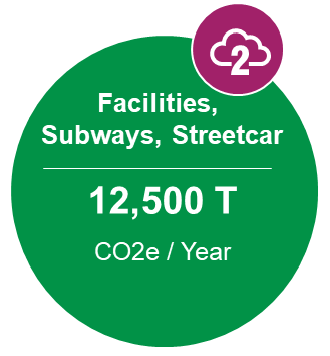Greenhouse gas (GHG) emissions inventory
The TTC’s GHG emissions impact can be divided into two categories:
- Direct and Indirect: In accordance with the Greenhouse Gas Protocol, our organization’s emissions are to be categorized as direct emissions (Scope 1) and indirect emissions (Scope 2 and Scope 3). City divisions, agencies and corporations have a responsibility to manage both.
- Avoided: Public transit systems are in the unique position to displace GHG emissions through mode shift from higher emitting modes such as personal vehicles, congestion reduction, and efficient land use. We have defined these as avoided emissions (Scope 4) to communicate how the TTC contributes to the reduction of GHG emission throughout the City of Toronto and beyond.

| Scope 1 | Scope 2 | Scope 3 | Scope 4 |
| Direct GHG emissions occurring from sources that are controlled or owned by the TTC | Indirect GHG emissions from purchased energy generated offsite but consumed by the TTC | All other indirect emissions that occur in the TTC’s value chain | Emission reductions that occur outside of a product’s life cycle or value chain, but as a result of the use that product |
TTC’s GHG Emissions Inventory
The TTC’s first Environmental Sustainability Report, set for release in 2025, will launch our annual reporting on progress in reducing GHG emissions and improving overall environmental sustainability. Our GHG emissions inventory is currently in development and will be updated continually as we refine our understanding and management of emissions.
Our GHG inventory follows an operational control approach to define its organizational boundary in accordance with the Greenhouse Gas Protocol. The operational control method is recommended by American Public Transportation Association's practice for quantifying greenhouse gas emissions from transit. There are 3 main asset types that TTC owns: fleets, facilities, and infrastructure. This approach accounts for all GHG emissions from assets that TTC has control in operational terms. This applies to assets where TTC has authority to introduce and implement its operational and Health, Safety and Environmental policies.
Below is a 2022 snapshot of TTC’s Scope 1 and Scope 2 GHG emissions in metric tonnes of CO2 equivalent that sets our emissions inventory.
Scope 1:

The sources of TTC’s scope 1 emissions are from fleet and facilities. Under this scope, the GHG inventory accounts for tailpipe emissions from TTC’s fleet, which includes:
- Diesel and hybrid-electric buses
- Gasoline Wheel Trans buses
- Diesel and gasoline non-revenue operational support vehicles
Natural gas emissions also fall under this scope. TTC has various building types that are accounted for in the GHG inventory, which include:
- Heavy maintenance facilities
- Bus garages
- Carhouses
- Stations
- Office buildings
Scope 2:

The sources of TTC’s scope 2 emissions are from electricity consumption from fleet and facilities. The assets that are accounted for under this scope include:
- Electric buses
- Electric Wheel Trans vehicles
- Electric non-revenue operational support vehicles
- Subways
- Streetcars
- TTC buildings
Scope 3:

Under scope 3 emissions, TTC’s emissions are from materials used for construction and repair of vehicles and facilities, and transportation from commuters travelling to the TTC network. The total scale of the TTC’s scope 3 emissions is currently unknown. However, there is work we can do today to both improve our understanding of value chain emissions and reduce them.
Scope 4:

Transportation is the second largest source of GHG emissions in Toronto. Public transit plays a crucial role in reducing city-wide GHG emissions by providing a low-emission mode of transportation compared to a personal vehicle. Under this scope, TTC’s transit ridership help to reduce GHG emissions from transportation in the city. TTC’s avoided emissions are still being defined. However, we will continue to ensure transit remains an attractive mode of choice by improving the speed and reliability of transit.
Contact us
 Fast fact #1
Fast fact #1
Between 2017 and 2023, we estimate we have decreased our GHG emissions by 20% organization-wide.
 Fast fact #2
Fast fact #2
Between 2017 and 2023, we estimate the TTC’s hybrid and electric buses saved 84 million litres of fossil fuel. That’s the equivalent to the water in 34 Olympic size pools.